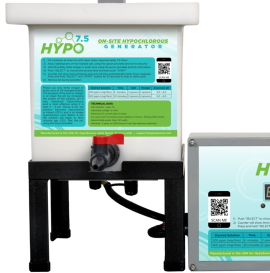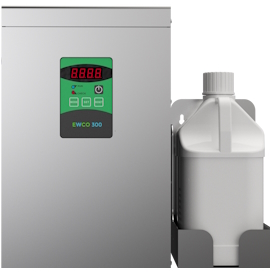Исследование > Микроб > Fungi > Candida
Часто используемые названия для растворов хлорноватистой кислоты
- Electrolytically Generated Hypochlorous Acid
- Neutral Electrolyzed Water (NEW)
- Electrolyzed Oxidizing Water (EOW)
- Electro-chemically Activated Water (ECA)
- Super-oxidized water (SOW)
Результаты: 4 опубликованные статьи

Microbe(s): Candida albicans
Wound infections involving Candida albicans can be challenging to treat becaof the fungus ability to penetrate wound tissue and form biofilms. The goal of this study was to assess the activity of a hypochlorous acid (HOCl)generating electrochemical scaffold (escaffold) against C. albicans biofilms in vitro and on porcine dermal explants (ex vivo). C. albicans biofilms were grown either on acrylicbottom sixwell plates (in vitro) or on skin tissue excised from porcine ears (ex vivo), and the polarized escaffold was used to generate a continuous supply of low concentration HOCl near biofilm surfaces. C. albicans biofilms grown in vitro were reduced to undetectable amounts within 24 h of escaffold exposure, unlike control biofilms (528 0034 log10 (CFU cm2) P < 00001). C. albicans biofilms grown on porcine dermal explants were also reduced to undetectable amounts in 24 h, unlike control explant biofilms (429 0057 log10 (CFU cm2) P < 00001). There was a decrease in the number of viable mammalian cells (356 64) in uninfected porcine dermal explants exposed to continuous HOClgenerating escaffolds for 24 h compared to explants exposed to nonpolarized escaffolds (not generating HOCl) (P < 005). Our HOClgenerating escaffold is a potential antifungalfree strategy to treat C. albicans biofilms in chronic wounds. Wound infections caused by C. albicans are difficult to treat due to presence of biofilms in wound beds. Our HOCl producing escaffold provides a promising novel approach to treat wound infections caused by C. albicans.

Microbe(s): Fungi, Candida albicans
The fungicidal influencing factors of electrolyzed oxidizing water (EOW) on Candida albicans were investigated by suspension quantitative germicidal tests. Results showed that EOW possessed predominant fungicidal rate on C. albican, as high as consummately 100% after 0.5 min duration of 65.5 mg/L active available chlorine concentration (ACC). The fungicidal effect was promoted proportionally along with ACC but was inhibited by organic interferential bovine serum albumin (BSA). The fungicidal mechanism was also investigated at a biological molecular level by detecting series of biochemical indices. Fluorescent microscopy showed that almost all C. albicans cells were stained red in 1 min, suggesting that cell membrane was one of EOW s action targets. Transmission electron microscopy (TEM) showed that EOW destroyed the cellular protective barriers and imposed some damage upon the nucleus area, which verified EOW s effects on microbial ultra-structures. EOW improved membrane permeabilities with the result that the leakages of cellular inclusions (K+, proteins and DNA) and the conductivity increased rapidly. The dehydrogenase relative activities of C. albicans decreased by 44.0% after 10 min, indicating that EOW also had a destructive effect on cellular dehydrogenase.

Microbe(s): Bacillus spores, Candida, Acinetobacter, Shigella, Serratia, Proteus, Pseudomonas, Mycobacterium tuberculosis, Mycobacterium avium, Mycobacterium abscessus, MRSA, VRSE
Background : Disinfection is essential for the prevention of hospital infection. Medilox, an super oxidized water generated by Medilox (SOO SAN EC CO., LTD. Yongin, Korea) was developed as a disinfectant in Korea. This is not costly and does not caany clinical problems and environmental pollution. We evaluated bactericidal activity ofMedilox against several clinical isolates and standard strains. Method : Clinical isolates and reference ATCC strains were exposed to Medilox, an super oxidized water (80 ppm ofHOCl) generated by Medilox (SOO SAN ECCO., LTD. Yongin, Korea) for the various periods (0.5, 1, 2, 5, and 10 minutes). After the exposure mixture of microorganisms and Medilox solution was inoculated into tryptic soy broth and onto tryptic soy agar, Sabouraud dextrose agar or Ogawa medium and cultured at 35C. Results: All strains of bacteria, yeasts, mycobacteria and vegetative form of Bacillus subtilis were killed within 30 seconds after an exposure to Medilox (80 ppm ofHOCl) under clean and dirty conditions. But, spore form of Bacillus subtilis was killed within 5 minutes. Conclusion: It may be recommended that Medilox can be used for the effective disinfectant for hospital environments and high-level disinfectant for hospital infection control.

Microbe(s): Fungi, Pseudomonas spp., Candida spp.
The effect of acidic, electrolyzed oxidizing (EO) water and chlorinated water on the spoilage microflora of processed broiler carcasses was examined. Carcasses were sprayed for 5 s at 80 psi with tap, chlorinated, or EO water in an inside-outside bird washer. Treated carcasses were then stored at 4 C for 0, 3, 7, or 14 d, and the microbial flora of the carcasses was sampled using the whole-carcass rinse procedure. Populations of psychrotrophic bacteria and yeasts in the carcass rinsates were enumerated. Results indicated that immediately after spraying the carcasses, significantly fewer psychrotrophic bacteria were recovered from carcasses sprayed with chlorinated or EO water than from carcasses sprayed with tap water. Furthermore, significantly fewer yeasts were recovered from carcasses sprayed with EO water than from carcasses sprayed with tap or chlorinated water. The population of psychrotrophic bacteria and yeasts increased on all carcasses during refrigerated storage. However, after 14 d of storage, significantly fewer psychrotrophic bacteria and yeasts were recovered from carcasses sprayed with EO water than from carcasses sprayed with tap or chlorinated water, and significantly fewer microorganisms were recovered from carcasses sprayed with chlorinated water than from carcasses sprayed with tap water. Pseudomonas spp. and Candida spp. were the primary microbial isolates recovered from the broiler carcasses. Findings from the present study indicate that EO water can effectively be used in inside-outside bird washers to decrease the population of spoilage bacteria and yeasts on processed broiler carcasses.
Best Hypochlorous Acid (HOCL) Generators
 Portable Hypochlorous Acid (HOCL) Machine
Portable Hypochlorous Acid (HOCL) Machine
Make high quality hypochlorous acid in the home or office.
$159.99 + Free Shipping
 HOCL Machine + Electrostatic Sprayer
HOCL Machine + Electrostatic Sprayer
Make hypochlorous acid and spray with an electrostatic cold fogger.
$309.98 + Free Shipping


